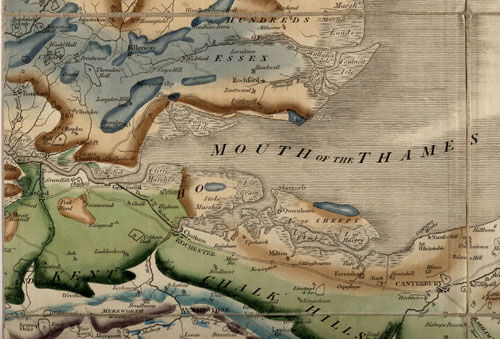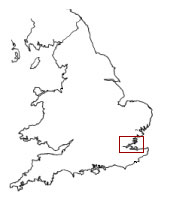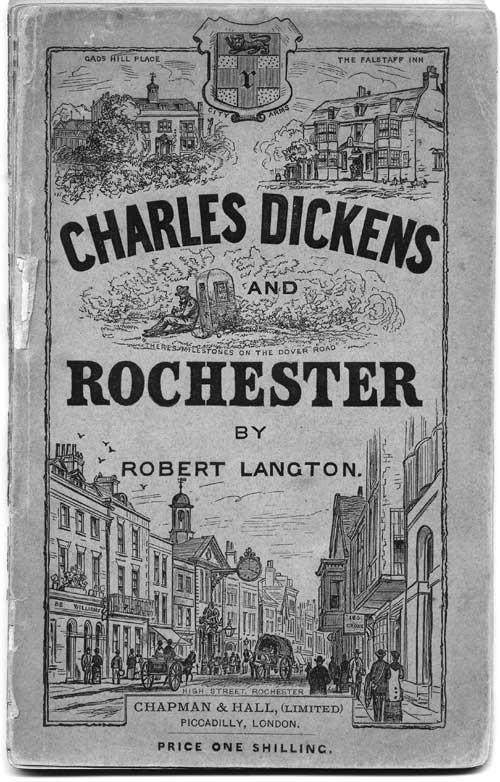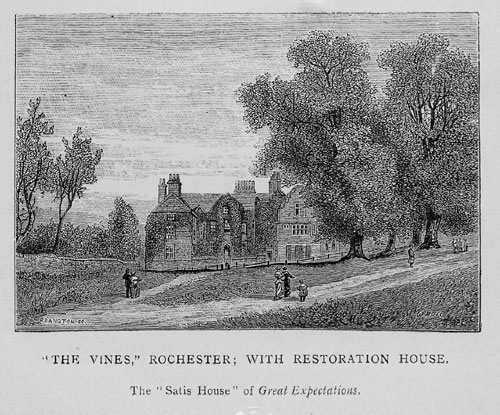|

NOTES ON THE NOVEL: ISSUE 3
Printable View
A Note on the Maps:
William Smith's 1815 Map and Delineation of
the Strata of England and Wales with Part of Scotland gives
a detailed account of the geography and geology of most of Great
Britain. It consists of several large maps, each about 16x24 inches,
mounted on canvas. These maps can be folded into smaller squares,
and some of the seams -- where the map folds and the canvas shows
through -- are visible on the sections of the maps reproduced here.
The whole work consists of 16 large maps (a "General Map"
of England, Wales and Scotland, and 15 regional maps), together
with a "Memoir" discussing the geological study they illustrate.
Detail from Map 12, in a reduced size, is reproduced here.

This portion of Smith's 1815 Map and Delineation
of the Strata of England [etc.] shows the area with which Chapters
8-10 of Great Expectations are concerned. Miss Havisham lives
in Rochester; Dickens was composing the novel at Gads Hill, near
Chatham.
This drawing of England indicates the portion
of the country illustrated by Smith's 1815 Strata map.

The cover (below) of Robert Langton's essay,
Charles Dickens and Rochester (1880), illustrates (to the
extent that the engravings are still legible) several pertinent
views.

In the upper left corner is an illustration of
Gads Hill Place, where Dickens had a house. Much of Great Expectations
was composed at Gads Hill, such that Dickens was close to the
scene of his narrative as he was writing it. Pip's market town (Rochester)
is near Gads Hill. The illustration at the bottom of the cover,
under the by-line, shows High Street in Rochester -- the location
of Uncle Pumblechook's corn-chandler's shop in the novel.
The illustration below, also from Langton's Charles
Dickens and Rochester (1880), shows the house on which Dickens
based Miss Havisham's mansion.

In Great Expectations, a brewery is attached
to the house instead of a vineyard, and the house is called "Satis
House" (its real name is "Restoration House"). According
to Smith's History of Rochester (478-9), Restoration House
was built in the late 16th century, and takes its name from a visit
(of May 28-29, 1660) of the restored monarch, Charles II. It is
still standing in Rochester today.
There are a number of remarkably snarling
passages in Shakespeare's Richard III. The first speech
in the play, and the first of Richard's soliloquies, is a good introduction
to Richard's habits of speech and thought:
Why,
I, in this weak piping time of peace
Have no delight to pass away the time,
Unless to spy my shadow in the sun
And descant on mine own deformity.
And therefore since I cannot prove a lover
To entertain these fair well-spoken days,
I am determin'd to prove a villain
And hate the idle pleasures of these days.
Plots have I laid, inductions dangerous,
By drunken prophecies, libels and dreams
To set my brother Clarence and the King
In deadly hate the one against the other.
And if King Edward be as true and just
As I am subtle false and treacherous,
This day should Clarence closely be mewed up
About a prophecy which says that "G"
Of Edward's heirs the murderer shall be. (I.i.24-40)
(The Duke of Clarence is a "G" because his name
is George. Richard has been deformed since birth, and is ambitious
to be King.)
Beggar my neighbor: The card game that
Pip plays with Estella is a simple children's game. The game is
played between two players, with a full deck; the object is to accumulate
all the cards. The deck is divided between the two players, and
the game commences when the first player plays a card, face up.
If the card is a number-card (2-10), the other player plays a card.
If, however, the card played is a court-card (jack, queen, king,
or ace), the other player has to play a certain number of cards
(if a jack was played by the first player, the second player must
play one card; if a queen was played, two cards must be played;
if a king, three cards; if an ace, four cards). If the cards thus
played in accordance with the appearance of a court-card are number
cards (2-10), player 1 (who played the court card) takes the trick
and adds it to the bottom of his/her part of the deck. If, however,
player 2 plays a court card in the process of furnishing the number
of cards required, the tables turn, and player 1 has to issue the
appropriate number of cards. The game goes on in this fashion until
one of the players has possession of the whole deck (Collins, "...Beggar
Your Neighbor"). Given the chief disparity between Pip and Estella
-- one of social class -- the name and nature of this card game
tends to reinforce the socio-economic significance of their encounter.
Dip-candle and no snuffers: A dip candle
was not moulded, like most modern candles, but rather "made by repeatedly
dipping a wick in melted tallow" (OED, "dip-candle"). The
Dictionary of Daily Wants (1858-9) gives the following account
of
SNUFFERS.
-- A kind of scissors constructed to cut off the superfluous wick
of the candle during combustion. Snuffers are very frequently
defective, either working so stiffly as to prevent their proper
application or opening and closing so loosely that no hold can
be retained on the wick.... Snuffers will sometimes not act, owing
to their becoming clogged with snuff; they should therefore be
cleaned out every day, to secure their efficiency. (921)
Mr. Wopsle's great-aunt's "low-spirited dip-candle
without snuffers" (Ch. 10) would have been a very poor light indeed.
Without snuffers, it would have smoked; with snuffers, there would
have been the additional inconvenience of that dysfunctional article.
One-pound notes: When Pip finds that the
shilling he has received from the stranger in the Three Jolly Bargemen
is wrapped in two one-pound notes, Joe and Mrs. Joe lay the money
aside as too great a sum not to be restored to its original owner.
Pip's shilling is worth 12 pence. The two pounds are worth 40 times
as much as the shilling (1s = 1/20£). One-pound notes were,
by the time Dickens was writing, an obsolete currency. They were
originally issued from 1797-1821, and briefly reissued during a
fiscal crisis in 1825-6. Easily forged, the English government tried
to phase them out in the early part of the century (Meckier 184).
Sedan-chair: Uncle Pumblechook interprets
Pip's (fallacious) report that he played with Miss Havisham and
Estella in a coach without any horses to it (Ch. 9) as a description
of a sedan-chair. According to the Oxford English Dictionary,
a sedan-chair was a carried conveyance, originally something like
a litter.
Rheumatic paroxysm: Rheumatism is "a disease
of which inflammation and pain of the joints are prominent features"
(OED, "rheumatism"). Many of the diseases called rheumatism
in Dickens' time are now known as distinct conditions (for example,
arthritis). Rheumatism was originally thought to be caused by "a
defluxion of rheum" (OED), meaning moisture or liquid from
mucous membranes or glands. 19th century manuals of domestic economy
prescribe various remedies, from blood-letting to draughts and pills.
The Dictionary of Daily Wants (1858-9) describes
RHEUMATISM.
-- A very painful disease which effects the muscles and joints
of the human body, chiefly the larger joints and most important
muscles, as those of and around the shoulder, hip, knees, and
back. Rheumatism is divided into acute and chronic; or that condition,
when the disease is in vigour and freshness attended with extreme
pain, and more or less of general fever, and that state, when
the system, by long acquaintance with the disease, has become
familiar to its attack, and it comes on from any trifling exposure
to cold, and after affecting a larger or smaller surface, declines
of its own accord -- all the symptoms, however, being materially
lighter than in the acute state. Besides being acute and chronic,
rheumatism is very often both general and local.... (842)
The form of rheumatism with which Mr. Wopsle's
great-aunt may be afflicted would presumably be a form of "general"
and "chronic" rheumatism, as the attack is apparently regular (occurring
each time the primer begins to circulate) and affects the whole
body. Her "paroxysms" are not those described by the Dictionary
of Daily Wants as pertaining to "acute" rheumatism, for she
exhibits no signs of "great heat, much thirst, headache, a quick
bounding pulse, [etc.]." Indeed, her pulse does anything but bound.
Bibliographical
information
|

